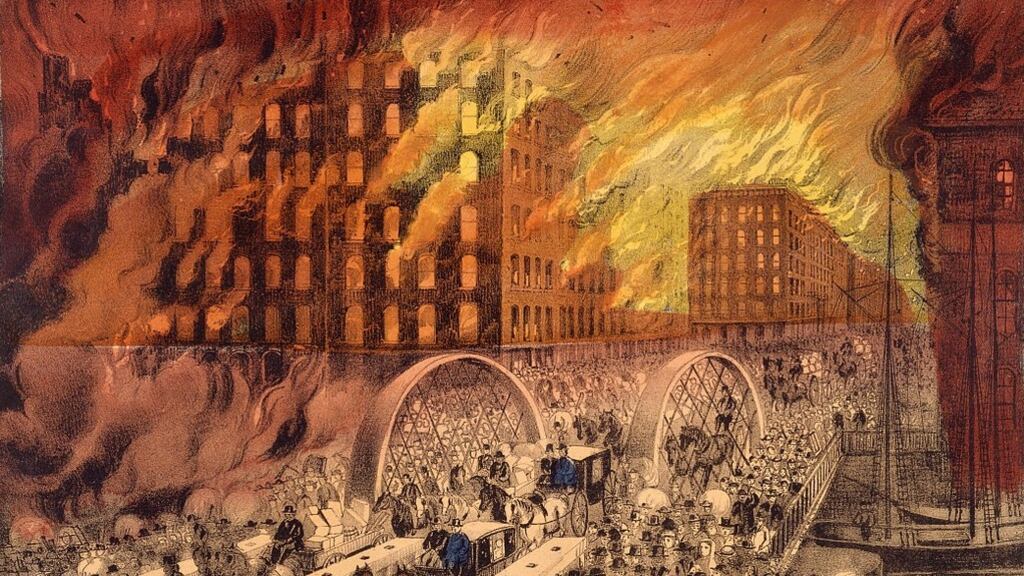In 1821, Chicago was a tiny village beside Fort Dearborn, the most western military base in the United States. Fifty years later, it was the fifth-largest city in the US, with a population of 334,000 people, including about 40,000 from Ireland. The Depot of the West, as it was dubbed, on the shore of Lake Michigan, had become a major transport and shipping centre with terminuses for 21 mainline railway tracks, and docks where 75 ships were loaded or unloaded each day.
Around 8.30pm on Sunday, October 8th, 1871, a rick of hay in a barn at DeKoven Street in the southwest of the city caught fire. Aided by a brisk wind, the flames spread quickly and by midnight buildings half a mile away were burning. On Monday morning, when the original fire had merged with others that had started independently, there was a general conflagration in the north and northwest of the city.
This part of Chicago contained some fine buildings, especially in the business district, but most were frame houses built with wood and tarred roofs that were bone dry because there had been no rain since July. The fire had also benefited from an unreliable alarm system and, although the brigade had good equipment, many of the crews were already exhausted after a12-hour shift fighting another fire on the previous day. The city’s water tower was an early victim and, once the pumps that drew water from the lake failed, the hoses fell dry and the fire could spread without hindrance.
It began to die out on Tuesday when some light showers fell but there were sporadic outbreaks until heavy rain fell on Saturday.
By then, 300 people had died, more than 90,000 were homeless, and miles of streets in an area of 2,100 acres, including almost all of the west division, and parts of the north and south divisions, were devastated.
Buildings worth $150 million, one-third of the property in the city, including 17,000 houses, churches, theatres, hotels, banks, warehouses, schools and the Cook County Court House, as well as railway carriages, and lumber and coal valued at $2 million were burned but, fortunately, the stockyards, most of the railway infrastructure and two-thirds of the grain elevators survived.
Inevitably, the police were overwhelmed and the mayor asked the commander of the North Western Military Department, the Irish-American Gen Phil Sheridan, to send troops to maintain order.
Meanwhile, on Monday evening, while the fire was still raging, the Chicago Evening Journal managed to publish an “Extra” edition which reported that because of the “Great Calamity of the Age”, the proud city was a mere shadow of itself, and buried deep in the copy there was a sentence that spawned an enduring myth: “the fire broke out at the corner of DeKoven and Twelfth Streets at about 9 o’clock on Sunday evening being caused by a cow kicking over a lamp in a stable in which a woman was milking”.
The woman was quickly identified as Mrs Catherine O’Leary, aged 35, an immigrant from Ireland who owned two houses and a barn with a herd of six dairy cows in the area. She maintained then and until she died in 1895 that she had milked the cows earlier and was in bed when the fire broke out, and to avoid publicity she always refused to be photographed.
Other stories also gained some traction. The fire might have been started inadvertently by boys playing dice in the barn or by one of the McLaughlin family who rented a cottage from Mrs O'Leary. According to this version, they were short of milk to make whiskey punch during a party for a cousin who had recently arrived from Ireland and when they annoyed one of the cows she lashed out at their lamp.
An official inquiry stated that there was no proof of anyone being in the barn and this conclusion was supported by the evidence of an amputee, Daniel Sullivan, who saw smoke rising from the building and claimed that he rushed into it to release the animals. Because of his disability, his story seemed dubious and he too became a suspect. In 1997, the Chicago Police and Fire Department finally exonerated Mrs O'Leary and her husband Patrick but the cause of the fire remains unknown.
The tragedy evoked the sympathy of people across America and abroad. More than $5 million was raised to help the homeless including $974,000 (about £184,000 at that time) from abroad of which $74,000 (about £14,000) was from Ireland.
Some insurance companies failed and others paid out only partially but work on the rebuilding of the city began almost immediately A Relief and Aid Society erected 4,000 houses within a month and nobody in the city went short of food or shelter during the winter. Four years later, the population had grown by another 100,000 people.
Today, the Chicago Fire Department’s Training Academy stands on the site of the barn.









